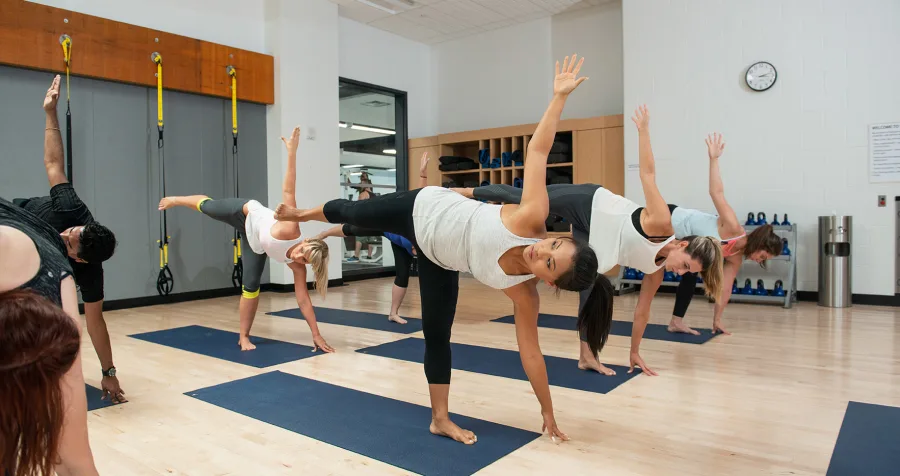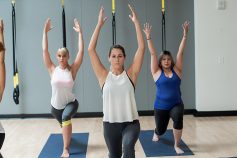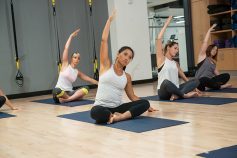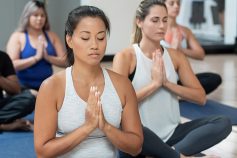3 easy ways to boost your mood with at-home yoga and meditation

We’ve all heard that practicing yoga can help you find balance — and we’re not just talking about standing on one foot. Yoga can help you restore your energy levels, find peace, and build overall emotional resilience during this tough, stressful time. And moving through life with more ease and less stress means more energy for the things you love! So we asked Emilie Wong, a yoga and meditation teacher, to share how yoga can help support your mental mental health. Here are her top three tips.
What can you do to stay optimistic, energized, and productive when this crazy situation and your many commitments start to take their toll? Well, yoga! Here are three easy things you can do right now, from the comfort and safety of your home, to help boost your emotional resilience and feel a little more positive and optimistic.
1. Connect mind and body through movement
 Asana, or the physical practice of yoga, loosens up your joints, builds strength, and counteracts the effects of our increasingly sedentary lifestyles. (Anyone else feeling a little cramped in their home office/at their
Asana, or the physical practice of yoga, loosens up your joints, builds strength, and counteracts the effects of our increasingly sedentary lifestyles. (Anyone else feeling a little cramped in their home office/at their While those are great benefits in and of themselves, yoga is also meant to prepare the body for meditation. Stiff joints or nagging back pain are distracting; loosening up and alleviating pain with regular yoga can help you clear your mind and live in the moment.
Try it at home:
Stand up tall with both feet planted on the floor. Start to notice how your weight sits in your feet. As you inhale, take your arms up overhead and reach for the sky. On your exhale, fold forward at the hips and allow your head, neck, shoulders, and arms to be weighed down to the ground. Stay in this forward fold for a few comfortable breaths, allowing your spine to lengthen. When you’re ready, press into your feet and roll up to standing as you inhale. Repeat the whole thing two to three times. As you go, gently note how this simple activity of connecting your breath to your movement can melt away stress and reduce stiffness in your spine and neck.
2. Breathe your way to enhanced focus

Try it at home:
Take a gentle breath in. As your lungs expand on the inhale, think of it as an opportunity to create more room within your body. When they deflate on the exhale, imagine letting go of any negative thoughts, tension, or residual energy. Repeat five times and then sit quietly with any sensations that arise. Allow your breath to return to normal.
If you’re about to do some self-guided yoga, or you want to enhance your virtual class, you can also set an intention for your practice by repeating a positive phrase towards yourself or someone close to you. Some examples of intentions I like are “I am radiant” and “sending out love.” Say one calmly in your head as you practice your breathing.
3. Build emotional resilience through meditation

Try it at home:
The best time to meditate is when you’ve warmed up your body and done some breath work. Set your alarm for five minutes so you’re not distracted wondering how long you’ve been meditating or how long you have left to go. Find a comfortable sitting position, keeping your spine long and resting your hands in your lap or on your knees. Start by gently closing your eyes, and tucking your chin in slightly towards your neck. Soften your jaw, throat, heart, belly, and base of your pelvis. Focus your attention on your breath: inhale through your nostrils, and exhale through your nostrils. Notice how your breath feels as it moves in and out of your body. Your thoughts will wander, and your mind will distract you from your breath. When you notice it happening, just return to your breath and notice sensations as they arise.
Many people feel great after just five minutes of meditating. But to really enjoy its effects on your mood, I recommend meditating every day for at least two weeks — and beyond.
To try yoga, breath work, and meditation, join one of our virtual classes, streaming live on our Facebook channel! All classes and activities are completely free for our community; no YMCA membership needed.










